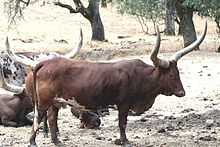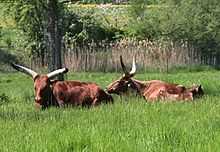Sanga cattle


Sanga cattle is the collective name for indigenous cattle of sub-saharan Africa. They are sometimes identified as a subspecies with the scientific name Bos taurus africanus.[1] These cattle originated in East Africa, probably western Ethiopia, and have spread west and south. Sanga are an intermediate type, probably formed by hybridizing the indigenous humpless cattle with Zebu cattle brought from Asia.[2] However, there is archaeological evidence, that these cattle type was domesticated independently in Africa, probably in North Africa, and that bloodlines of taurine and zebu cattle were introduced only within the last few hundreds years.[3] Although the timeline for their history is the subject of extensive debate, some authors date the first Sanga cattle to 1600 B.C.[4] They are distinguished by having small cervico-thoracic humps instead of the high thoracic humps which characterize the Zebu.
Breeds of Sanga Cattle
- Abigar
- Afrikander
- Ankole-Watusi
- Bonsmara (a breed developed in the 1940s in South Africa)
- Nguni
- Red Fulani
- Tuli
- Tswana
References
- ↑ Relationships between production and product traits in subpopulations of Bonsmara and Nguni cattle P.E. Strydom1, R.T. Naudé, M.F. Smith, A. Kotzé, M.M. Scholtz and J.B. van Wyk, South African Journal of Animal Science 2001, 31(3)
- ↑ Mukasa-Mugerwa, E. (1989). "A review of reproductive performance of female Bos Indicus (Zebu) cattle". International Livestock Research Institute. Retrieved 2010-03-02.
- ↑ Caroline Grigson: An African origin for African cattle? — some archaeological evidence. African Archaeological Review 1991, Volume 9, Issue 1, pp 119-144
- ↑ References Payne, 1964 and Schoeman, 1989 in Relationships between production and product traits in subpopulations of Bonsmara and Nguni cattle P.E. Strydom1, R.T. Naudé, M.F. Smith, A. Kotzé, M.M. Scholtz and J.B. van Wyk, South African Journal of Animal Science 2001, 31(3)